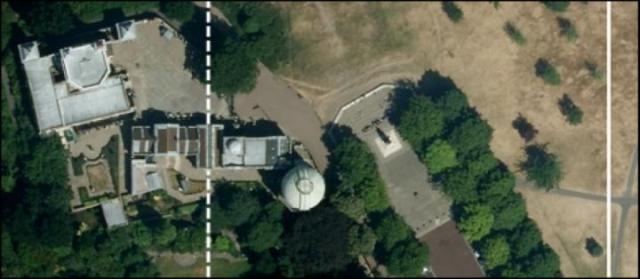Aug 12 2015
In 1884, a delegation of international representatives convened in Washington, D.C. to recommend that Earth's prime meridian (the north-south line marking zero degrees longitude) should pass through the Airy Transit Circle at the Royal Observatory in Greenwich, England.
 The Airy meridian is marked as the "Prime Meridian of the World" (dotted line), and the modern reference meridian indicating zero longitude using GPS (solid line).
The Airy meridian is marked as the "Prime Meridian of the World" (dotted line), and the modern reference meridian indicating zero longitude using GPS (solid line).
(A transit circle is an instrument for measuring star positions, and could be used for determining local time; this one was named for its designer, British Astronomer Royal George Airy.)
But modern navigators, mapmakers, surveyors and London tourists now find that zero longitude runs 334 feet east of the telescope, according to GPS receivers. Why?
Largely because newer technologies - primarily the superb accuracy of the global positioning system, which uses satellites to precisely measure grid coordinates at any point on the Earth's surface - replaced the traditional telescopic observations used to measure the Earth's rotation.
A newly published paper in the Journal of Geodesy details the differences.
"With the advancements in technology, the change in the prime meridian was inevitable," said Ken Seidelmann, an astronomer at the University of Virginia and co-author of the study. "Perhaps a new marker should be installed in the Greenwich Park for the new prime meridian."
Seidelmann and his colleagues from the U.S. Naval Observatory, the National Geospatial-Intelligence Agency and the U.S. company Analytical Graphics Inc. concluded that a slight deflection in the natural direction of gravity at Greenwich is responsible for the offset, along with the maintenance of continuity of astronomical time.
The research shows that the 102-meter offset can be attributed to the difference between two conventional methods of determining coordinates: astronomical versus geodetic, which refers to a set of reference points used to locate places on the Earth. Their difference is known as "deflection of the vertical," and high-resolution global gravitational models confirm that the east-west component of this deflection is of the proper sign and magnitude at Greenwich to account for the entire shift.
Because the Earth is not perfectly round, and because different locations on Earth have different terrain features affecting gravitational pull, traditional ways to measure longitude have built-in variations, or errors, based on the specific location where measurements are taken. The observations were based on a vertical determined from a basin of mercury and were dependent on local conditions. However, Seidelmann said, GPS measures vertical from space in a straight line directly through the center of the Earth, effectively removing the gravitational effects of mountains and other terrain.
Meridian, he said, is dependent on the direction of the vertical, which is gravity- and observational-method-dependent. The distance and direction of the 102-meter offset is confirmed by gravitational models.
For supporting evidence, the authors also analyzed the differences in the coordinates of many former timekeeping observatories to affirm that the apparent longitude shift at Greenwich is a localized effect due to the direction of gravity at Greenwich, and not a global shift in the world's longitude system.